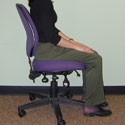Safety & Well-being
Login Tools
My Human Resources
Enter direct banking information, view earnings statements, change your address & manage training. [ LOGIN]
Pension Account
View pension plan balances and investment mix and choose your investments. [ LOGIN]
Manulife
Check and submit claims, get forms, print Manulife card. [ LOGIN]
Faculty Staff Resources
Salary ranges, pay schedules and related information. [ LOGIN]
Researcher Toolbox
Hiring/appointing research roles, including budgeting for salary and benefit costs. [ LOGIN]
Administrator Toolbox
Appointments and pay administration, offer templates. [ LOGIN]
Leader Toolbox
Help with recruiting, hiring, enhancing performance. [ LOGIN]
Western Financial
Submit expenses, PER inquiry, research grants. [ LOGIN]
Step 2: Workstation Set-up

Follow this step-by-step guide when setting-up your workstation.
I. Adjusting your Chair
With your hips pushed to the back of the seat, adjust the backrest height so that the rounded part fits the curved section of your lower back (lumbar spine). Adjust the seat height so your feet are flat on the floor with your knees at or slightly below the level of the hips. Recline the backrest angle between 95 and 110 degrees so that both upper and lower parts of the back are supported. Make sure to adjust the backrest angle regularly throughout the day.
Adjust the armrest height to avoid contact with the desk or keyboard etc. Make sure the armrests do not elevate your shoulders or limit your ability to use the computer. If so lower them or remove them.
II. Positioning the Mouse and Keyboard
After pulling up close to the keyboard and mouse, position them in front with the most frequently used portion of the keyboard centred to your location
Adjust the height of the keyboard or chair so that your shoulders are relaxed at your sides with the keyboard and mouse at elbow height (elbows bent to 90 degrees). Use a footrest if your feet are elevated off the floor.
Keep your wrists straight by adjusting the keyboard tilt. If sitting upright, try tilting the keyboard away from you.
Wrist rests can help to maintain neutral wrist postures and reduce contact stress against hard surfaces. However, some computer users may find wrist rests limit hand positions and increase the effort of keying.
Look at the position of the mouse. Can it be placed closer to you without affecting it’s function? Is the mouse located just below elbow height? Have you thought of using the mouse with the left hand?
III. Adjusting the Monitor, Telephone and Reference Documents
Position the top of the monitor at eye level. If you where bifocals either push the monitor back or lower the unit until you can read the text without seeing blurry areas or bending your neck.
Centre the monitor to your normal working position.
Position the monitor at an arm’s length distance between you and the screen with your back against the backrest. Fine tune the distance to your preferred visual comfort. Consider adjusting the size of the font to accommodate the desired depth.
Do you experience glare from windows or lights? Can you set-up your computer adjacent to the window? Try closing the blinds, and adjusting the angle of the screen. Polarizing filters may help to reduce glare.
Documents referenced regularly are best positioned between the screen and keyboard using a specific copy stand.
Place items close to your position based on how often you use them. Regularly used items should be placed within an easy to reach location.
Are you required to use the phone while using the computer? You may benefit from the addition of a telephone headset or speaker phone. This will eliminate any cradling of the headset between the side of the head and the shoulder.
Published on and maintained in Cascade CMS.









